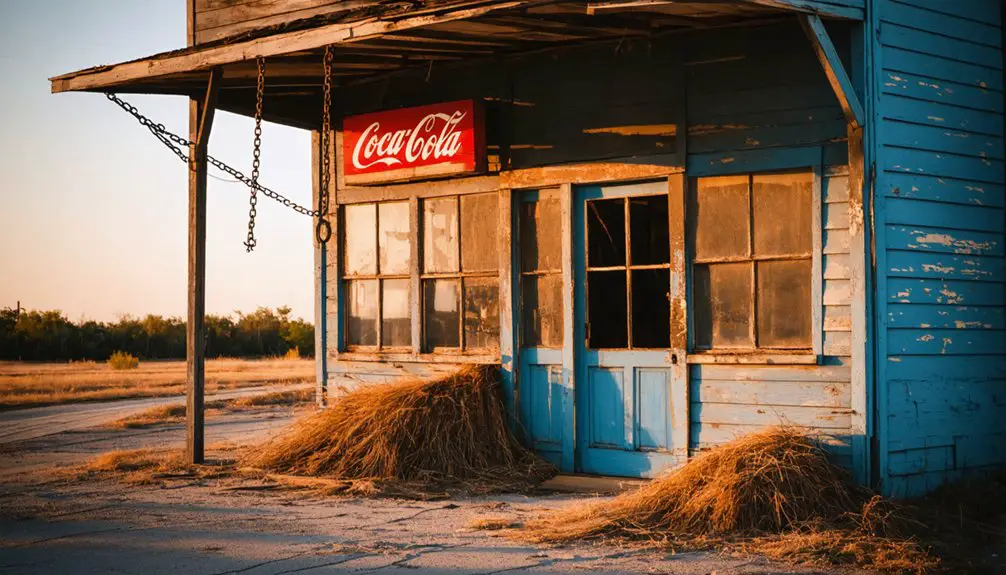You’ll find Marshall Town in central Oklahoma, where a bustling prairie settlement established in 1889 has dwindled from 700 residents to just 233 today. The town’s unique wide main street, designed for mule teams by founder Sylvan T. Rice, still showcases its rich history. While not a true ghost town, Marshall’s story weaves together tales of oil booms, outlaws like the Dalton Gang, and pioneering settlers whose legacy echoes through its quiet streets.
Key Takeaways
- Marshall’s population declined from 700 in 1930 to 233 today, following the 1980s oil bust and economic downturn.
- The once-thriving downtown commercial district experienced significant business closures after the oil industry collapse.
- The town maintains occupancy but struggles with a 21% poverty rate and limited employment opportunities.
- Despite economic challenges, Marshall remains inhabited rather than abandoned, distinguishing it from true ghost towns.
- The historic wide main street and original buildings remain as remnants of Marshall’s prosperous railroad and oil boom era.
The Birth of a Prairie Settlement
When the Unassigned Lands of central Oklahoma opened to settlers in April 1889, the area that would become Marshall Town began taking shape through the determined efforts of its earliest pioneers.
You’ll find the story of Sylvan T. Rice and his family, who arrived from Kansas with covered wagons and a surrey, facing settler challenges like constructing dugouts and sod houses for shelter.
By July 1894, Rice’s determination led to the establishment of the town’s first store, marking a significant milestone in the settlement’s development.
The opening of Rice’s general store in 1894 marked a pivotal moment in Marshall Town’s transition from settlement to established community.
Community gatherings centered around the Baptist Church, established in 1892, followed by Methodist and Disciples of Christ congregations.
The prosperity of Fort Washita in 1842 influenced early settlement patterns in the region.
The town’s formal layout emerged in January 1894 when Roy E. Stafford, Irvin H. Stafford, and Joseph Cromer filed the official town plat. The settlement received its name from Marshalltown, Iowa when it was granted postal designation in March 1890.
From Mule-Turns to Main Street Design
If you’ve ever wondered about Marshall’s famously wide main street, you can thank developer Sylvan Rice’s practical vision of accommodating full mule teams needing to turn around.
This expansive design, reportedly wide enough for 16 cars across, reflected the late 1800s’ agricultural and freight transportation needs while anticipating future streetcar development.
The generous width would later prove invaluable for hosting major community events, including the “Biggest Little Band Festival in the World” from 1938 to 1951, though today’s quiet street stands as a reflection of the town’s evolution from bustling prairie settlement to ghost town. Similar to many frontier settlements, the area faced challenges from outlaw gang activity, with the notorious Doolin Gang frequently hiding in the region. Like many other Oklahoma settlements, Marshall’s decline came from a combination of resource depletion and the steady migration of residents to larger urban centers.
Wide Street Origins
Though many frontier towns featured standard-width streets, Marshall’s expansive main thoroughfare emerged from a practical need: accommodating the wide turning radius of mule teams.
Townsite developer Sylvan Rice specifically designed the street’s width around the maneuverability requirements of these essential transport teams, which proved vital for the late 19th-century frontier community. Like many disambiguation pages, the town’s name required careful distinction from other similarly-named locations across America.
You’ll find this purposeful street design created enough space for up to 16 horse-drawn or motor vehicles to line up across its width. The town’s design choices reflected a journey from past to present, much like the evolution of transportation itself.
While originally conceived for mule transport, the broad thoroughfare adapted perfectly to the town’s evolving needs, supporting everything from emergency vehicles to the region’s famous band festivals.
This forward-thinking street design became Marshall’s defining feature, earning its self-proclaimed title as having the “widest street in the world.”
Transportation Shapes Design
As Marshall’s transportation needs evolved from mule teams to automobiles, the town’s design adapted remarkably well to changing times. The wide streets, originally planned for animal-drawn transport, proved perfect for the motor age.
You’ll find that Marshall’s transport networks shaped not just traffic flow, but the entire community’s development.
- Main Street’s exceptional width accommodated up to 16 cars side-by-side during festivals
- The 1902 railroad arrival sparked urban sprawl toward the tracks, reshaping commercial activity
- Oil boom traffic in 1927 demanded infrastructure capable of supporting heavy machinery
- Street dimensions that once served mule team turns later proved ideal for automobile traffic
Similar to how Pleasant Valley’s railroad contributed to significant growth between 1910 and 1930, Marshall’s layout demonstrated the vital role of transportation infrastructure in shaping town development.
These adaptable design features showcased Marshall’s forward-thinking approach, even though some planned elements, like streetcars, never materialized.
The town’s layout continuously evolved to meet changing transportation demands while maintaining its practical functionality.
Legacy of Mule Planning
Marshall Town’s distinctive street layout originated from a simple yet ingenious design principle: the turning radius of a mule team. Developer Sylvan Rice’s experience with mule transportation shaped what would become one of Oklahoma’s most remarkable urban design features – a main street wide enough to accommodate 16 cars side by side.
You’ll find this mule-inspired width wasn’t just about transportation. It transformed into a vibrant community space, hosting the “Biggest Little Band Festival” from 1938 to 1951, and supporting the town’s growth through the Cherokee Strip opening and oil boom years.
While modern streets prioritize vehicle speed, Marshall’s design created a multi-use public space that balanced everyday transit with large gatherings. Today, these expansive streets stand as a reflection of practical, forward-thinking planning that put community needs first.
Railroad Arrival and Economic Boom
When the Denver, Enid and Gulf Railroad laid tracks through the area in 1902, it forever transformed the rural settlement into a bustling economic center.
You’ll find that local visionaries like Sylvan Rice seized the opportunity, forming a townsite company and offering a $20,000 premium to guarantee the railroad’s proximity. This strategic railroad expansion catalyzed Marshall’s economic transformation, leading to incorporation in 1903. The town’s founder had moved from Marshalltown, Iowa, bringing his hometown’s name to this new settlement. Like their Iowa counterparts who celebrated with speeches and festivities, the townspeople marked the arrival of their first train with great fanfare.
- Cotton gins, grain elevators, and milling companies sprouted up, processing local agricultural bounty
- Your town’s population surged from hundreds to nearly 700 by 1930
- Feed stores, hatcheries, and produce businesses diversified the local economy
- Three passenger rail depots connected you to major cities, boosting mobility and commerce
The railroad’s arrival positioned Marshall as a crucial regional hub, weaving together commerce, agriculture, and community growth.
Oil Discovery and the Roxanna Field
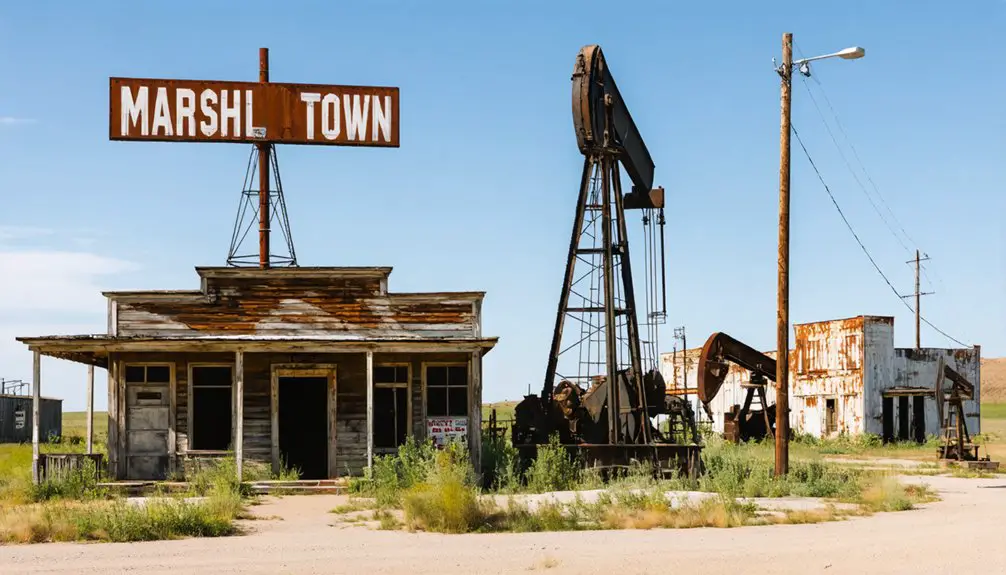
The discovery of the Roxanna Oil Field in 1927 marked a pivotal moment in Marshall’s evolution from a railroad hub to an energy powerhouse.
When the McCully well struck oil at over a mile deep – the first well of such depth in Oklahoma – you’d have witnessed a technological breakthrough that would transform the region’s destiny.
The Roxanna discovery triggered profound changes on Marshall’s landscape.
You’d have seen the rapid emergence of drilling operations, support industries, and a surge of workers seeking opportunities in the booming oil sector.
Located in Logan County, the oil field’s impact reached far beyond the town’s borders, contributing to Oklahoma’s rising status as a major petroleum producer.
This deep-drilling success proved Marshall’s potential for industrial growth beyond its agricultural and railroad roots, setting the stage for decades of energy production.
Music and Culture in Marshall’s Golden Age
While oil wealth fueled Marshall’s economic growth, the town’s cultural heart beat strongest through its vibrant music scene. Folk traditions and community gatherings defined Marshall’s golden age, with music weaving through every aspect of daily life.
You’d find the sounds of celebration echoing from various venues across town:
- The gymnasium hosted lively dances and performances, bringing townspeople together for memorable evenings.
- Local churches filled the air with hymns and featured musical events that reinforced community bonds.
- Social clubs like the Odd Fellows and Masonic lodges organized regular performances during their meetings.
- Annual celebrations, including the firemen’s rib dinner, showcased local talent and preserved cultural heritage.
Native American influences, settler ballads, and regional country music blended to create Marshall’s unique musical identity, even as economic tides shifted through the years.
Notable Characters and Outlaw Tales
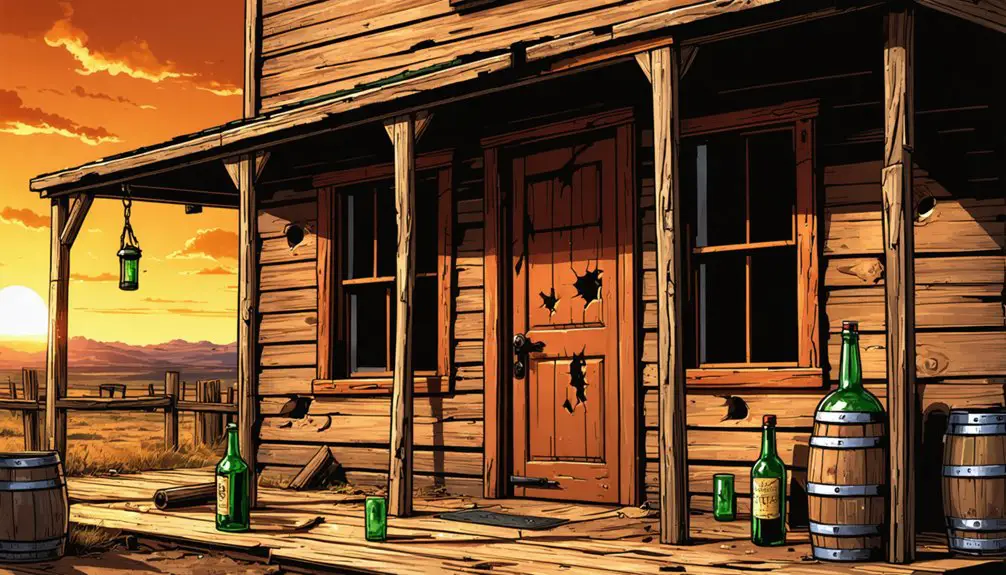
If you’d visited Marshall during its frontier days, you might’ve crossed paths with the infamous Dalton Gang, who once peacefully purchased supplies from a local general store before continuing their journey.
The town’s most dramatic outlaw tale centers on Dick Yeager, also known as Zip Wyatt, who met his violent end just five miles southwest of Marshall after being shot.
While Marshall never became a permanent haven for outlaws, its strategic location during the land runs made it an occasional stopover for frontier criminals passing through the territory.
Dalton Gang Supply Stop
During the early 1890s, Marshall Town served as one of several essential supply stops for the notorious Dalton Gang‘s operations across Oklahoma Territory. The town’s strategic location and sympathetic locals made it an ideal hub for the gang’s supply logistics, allowing them to maintain their daring raids across the region.
- Bob and Emmett Dalton frequently used the town to gather horses, weapons, and ammunition.
- Local merchants and saloons provided food, shelter, and crucial intelligence about law enforcement movements.
- Bill Dalton operated as an informant, gathering information while blending in with townspeople.
- The gang’s presence brought a mix of fear and economic benefit to local businesses.
You’ll find that Marshall Town’s role as a Dalton Gang stronghold contributed appreciably to both its historical significance and eventual transformation into a ghost town.
Dick Yeager’s Fatal End
After terrorizing the Oklahoma Territory with a string of violent crimes, Dick Yeager’s outlaw career came to a dramatic end in the summer of 1895.
You’ll find that Yeager’s downfall began during a fierce shootout with lawman Marion Hildreth’s posse at a homesteader’s cabin north of Cainville.
While his partner Ike Black died instantly in the gunfight, Yeager managed to escape despite being seriously wounded, sprinting across a sand hill and into a cornfield under heavy fire.
Though he’d previously survived encounters with law enforcement, including killing Deputy Andrew Balfour in Kansas, this wound proved fatal.
His outlaw legacy lives on in the stories of Oklahoma Territory’s most notorious criminals, where he’d built a reputation that earned him a $5,000 bounty and connections to the infamous Doolin Gang.
Author Angie Debo’s Legacy
Scholar and historian Angie Debo stands as one of Marshall Town’s most influential figures, chronicling Oklahoma’s complex history through her pioneering research and fearless writing.
You’ll find Debo’s influence woven throughout Marshall’s story, from her arrival by covered wagon in 1899 to her groundbreaking works that reshaped our understanding of Native American history.
- Challenged historical accuracy by incorporating tribal oral histories and records, moving beyond government-only sources
- Wrote “Prairie City” based on Marshall’s community, preserving local heritage
- Confronted powerful interests to expose the truth about Native American land seizures
- Earned recognition as Oklahoma’s greatest historian while maintaining deep roots in Marshall
Through her dedicated scholarship and brave pursuit of truth, Debo transformed Marshall from a simple prairie town into a symbol of Oklahoma’s complex heritage.
Downtown’s Rise and Slow Decline
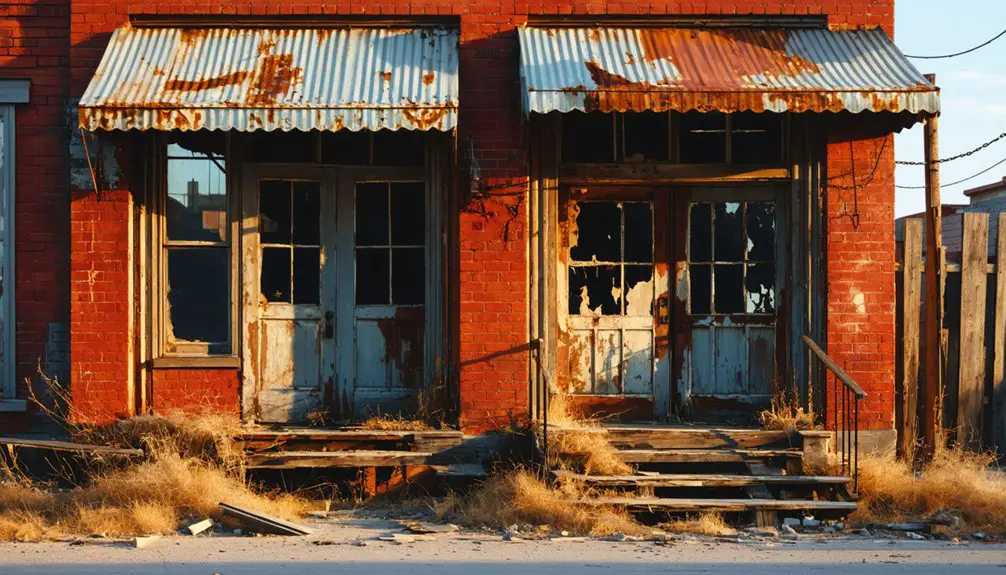
Marshall Town’s downtown district emerged as a vibrant commercial hub following the arrival of the railroad in 1902, when businesses relocated closer to the tracks to capitalize on the new transportation link.
You’d have found a bustling community with diverse establishments, from the five-and-dime store to professional offices, reflecting strong economic shifts through the mid-1900s.
The discovery of the Roxanna oil field in 1927 further transformed community dynamics, bringing workers and wealth to the area.
The Roxanna oil field’s discovery unleashed a wave of prosperity, as workers and wealth poured into Marshall Town’s growing community.
The town’s spirit shone brightest during its “Biggest Little Band Festival,” drawing thousands of participants from 57 towns.
But the 1980s oil bust marked a turning point – businesses shuttered, buildings fell into disrepair, and the population shifted to farming and commuting.
Today, only the post office and farmers’ co-op remain as echoes of the once-thriving downtown.
Legacy of Historic Buildings and Cemeteries
While downtown’s commercial significance faded, the architectural and spiritual heart of Marshall endures through its historic religious structures and burial grounds.
Historic preservation efforts have focused on key landmarks like the Methodist Church and Angie Debo House, both now listed on the National Register of Historic Places. You’ll find Marshall’s community heritage deeply rooted in these sacred spaces.
- The Methodist Church stands as a symbol of the town’s religious foundation, built during Marshall’s early development.
- Two IOOF cemeteries mark the final resting places of pioneering families and tell stories of the town’s social fabric.
- Early Baptist and Disciples of Christ congregations established churches that served as essential community gathering spaces.
- The historic church buildings mirror the town’s journey, from bustling prosperity to quiet remembrance.
Modern Life in a Vanishing Town
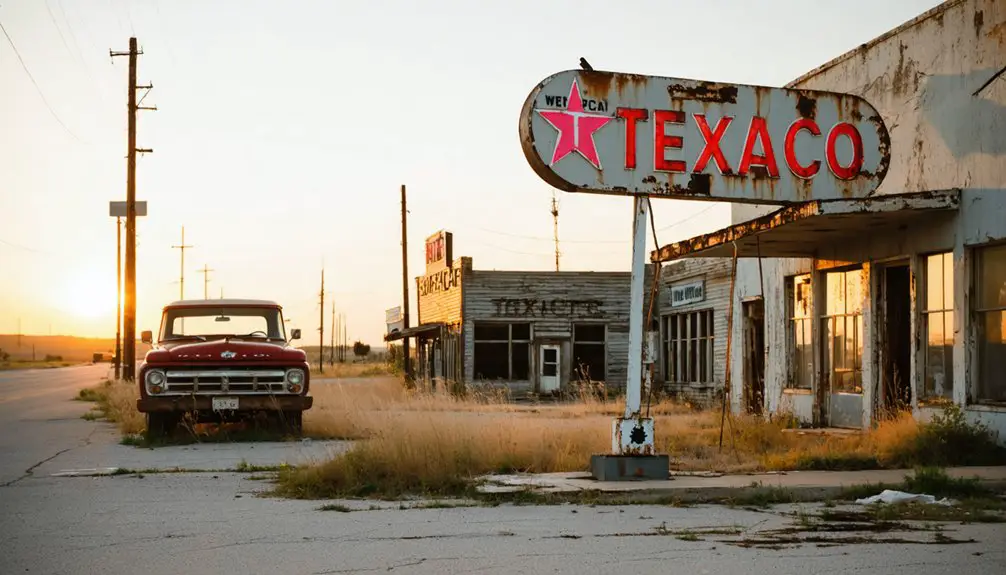
Despite its modest size, life in modern Marshall presents a complex portrait of rural resilience and demographic change. You’ll find a tight-knit community of just 233 residents, where the median age of 54 reflects an aging population adapting to contemporary challenges.
The town’s proximity to Oklahoma City offers a lifeline, attracting those seeking affordable housing while maintaining access to urban amenities.
Community resilience shines through as residents navigate a 21% poverty rate and limited local employment. Some newcomers, including van life enthusiasts, are drawn to Marshall’s low population density and relatively affordable housing options.
While the town’s small footprint of 0.64 square miles might seem constraining, it’s fostered a close-knit atmosphere where neighbors know each other and work together to preserve their rural way of life.
Frequently Asked Questions
What Was the Average Population of Marshall During Its Peak Years?
Like a bustling beehive at its prime, Marshall’s peak demographics averaged 658 residents during its strongest years in the early 1900s, with census records showing fluctuations between 622-695 between 1910-1930.
Are There Any Preserved Historical Buildings Open for Tourist Visits?
You’ll find two main historic preservation sites open for tourists: the Methodist Church of Marshall and the Angie Debo House, both listed on the National Register of Historic Places.
What Happened to Marshall’s School System After the Town’s Decline?
You’d be surprised how quickly a vibrant school system vanished – Marshall faced school closures through the 1970s-80s, with educational decline forcing consolidation into Covington’s district after the high school closed in 1976.
How Many Residents Currently Live Within Marshall’s Town Limits?
You’ll find between 226 to 236 residents currently living within Marshall’s town limits, showing modest growth from the 2020 census count of 210 people, based on current demographics and town history.
Does Marshall Still Hold Any Community Events or Annual Celebrations?
Like a faded photograph, Marshall’s community gatherings have vanished. You won’t find any local traditions or celebrations there today, as it’s completely abandoned with no remaining active population or events.
References
- https://www.kosu.org/arts-culture/2014-02-07/ghost-towns-ingalls
- https://en.wikipedia.org/wiki/List_of_ghost_towns_in_Oklahoma
- https://www.kaypratt.com/off-the-beaten-path-marshall-ok/
- https://en.wikipedia.org/wiki/Marshall
- https://www.okhistory.org/publications/enc/entry?entry=MA029
- https://www.thevillageok.gov/229/The-History-of-The-Village-by-B-Stone
- https://www.okhistory.org/publications/enc/entry?entry=MA030
- https://debo.library.okstate.edu/community/prairie-city-days
- https://www.okgenweb.net/~okmarsha/history.html
- https://www.youtube.com/watch?v=fUidKBsn7Ck
